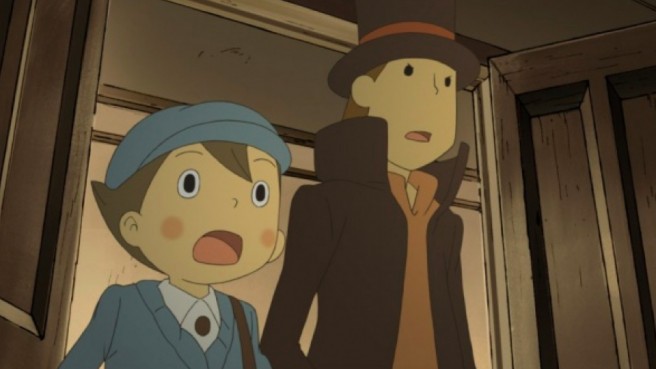Level-5 talks Professor Layton’s origins, determined to keep series going
Eurogamer has put up a new piece detailing the origins of Professor Layton. The site spoke with Level-5 CEO and president Akihiro Hino, who also briefly touched on the series’ future.
Head past the break for the rundown of what Hino shared. You can also find comments from Professor Layton’s voice actor here.
– Hino had the idea for a series of puzzle games based on the Atama no Taisou series of puzzle books
– Hino grew to love these books as a child
– The books were written by Professor Akira Tago from Chiba University
“We thought we could turn these books into a pleasant, casual game by just adding a few game-like elements.”
– Level-5 started a prototype in 2006
– Worked directly with Professor Tago to translate his riddles into video game form
– Level-5 couldn’t get the Atama no Taisou name due to copyright infringement
– The demo was at an advanced enough stage to provide Level-5 with a route forward
“We’d created a bonus mode in which the player would solve puzzles as part of a story. So we developed this mode and created a story based around the puzzles you’d find in Tago’s books.”
– Hino decided to create a pair of characters for the player to inhabit
“We wanted to offer two intelligent characters who could bounce ideas off each other.”
– Took inspiration from Sir Arthur Conan Doyle’s pair of proto-detectives, Sherlock Holmes and Doctor Watson
– Hino asked one of his artists to draw an English gentleman and a younger character
“When I saw the illustrations I temporarily named them Professor Layton and Luke. The names seemed to fit perfectly and before I knew it they’d stuck. The characters stayed just as I had conceived them at the beginning.”
– Hino began by writing an outline of the game’s basic plot
– It was a story of a wealthy widow, Lady Dahlia, whose late husband’s fortune was tied up in an unsolved riddle
– She wrote to Professor Layton inviting him to her hometown, St. Mystere, to try and help access the fortune
“I begin each game with just the world view and game concept. Then I write until finally I end up with maybe around 50-100 pages that can be used as a working script. This is then broken down into the game’s dialogue and text.”
– All but 30 of the puzzles featured in the game were drawn from Tago’s previous book
– All others were written specifically for the project
“To this day we design the puzzles via a process we call ‘Puzzle Camp’. The puzzle team, headed by Professor Tago, and the game development team spend several days’ together away designing puzzles. We are all extremely passionate about the puzzles and often our discussions become pretty heated.”
– Tago and the Level-5 team kept the balance of riddles in mind right from the start of the process to ensure there was no bias towards questions based on maths, geometry or plain tricks
“Math-based puzzles are especially tricky as it is easy to see them as something right out of say a calculus class. We use descriptive text and illustrations to make these puzzles look and feel interesting – even at a glance, they rely heavily on a flash of inspiration.”
– Professor Layton was taking shape when Brain Age was gaining success
“Even people who didn’t usually play games bought a Nintendo DS just to train their brains. We did a lot of a research on Dr Kawashima’s Brain Training to anticipate what these new players wanted to play next.”
– Hino knew that the brainteasers at the heart of Professor Layton and the Curious Village would appeal to the Brain Training audience
– Hino was also concerned that the supplemental game elements would prove off-putting
“We worked hard to identify game components that are generally considered integral to games but are inessential and which could be set aside. For example, in the Professor Layton series, you can progress in the game without solving a difficult puzzle and choose to solve it later on instead. This is an unusual approach in game design, but it was quite deliberate.”
– Selecting the right voice actor to play the role of Layton was crucial to complete the aesthetic
“I don’t just concern myself with finding a voice that matches the image I have of the character when casting. I also place heavy emphasis on how much the actor can perform as the character. If I can clearly imagine how the character would look while they speak, I can usually quickly find the appropriate casting.”
– Hino had few doubts that the game would be a success
“As soon as the game entered testing I knew that we had made something entirely new, and I knew it would be well received.”
– By August 2013, the six games in the series enjoy combined sales of 15 million units, three million copies more than Tago’s series of puzzle books sold since their debut in 1966
– Hino is determined it’s not the end for the series
“I don’t plan on letting Layton end here. While Hershel Layton’s personal story is now finished, we intend to continue on with the challenge of adding more unique Professor Layton titles to the overall series.”
– Hino’s favorite puzzle is Wolves and Chicks
“Remember the river crossing puzzle, Wolves and Chicks, from Professor Layton and the Curious Village? I’m fondest of this puzzle. It has such a deep intricacy. I still want to solve it over and over.”
